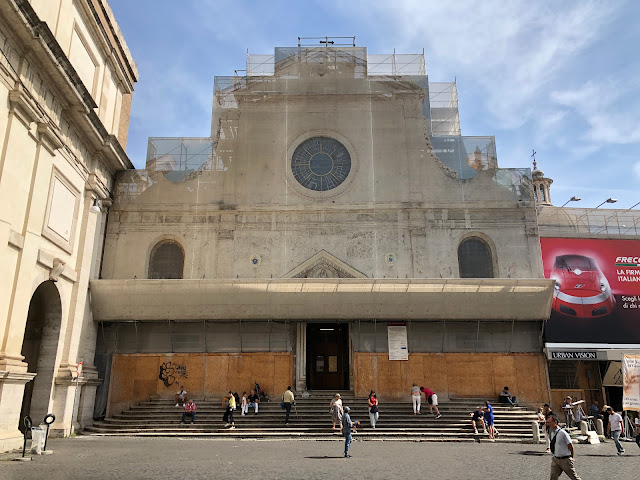【ローマ】サンタ・マリア・デル・ポポロ教会 Roma - Santa Maria del Popolo
コロンナ宮殿から地下鉄を乗り継いで、昨日訪れたポポロ広場にやってきた。
かつて巡礼者たちを迎えたポポロ門を入ってすぐの場所に、サンタ・マリア・デル・ポポロ教会が建っている。
訪れた時にはファサードの改修が行われていて、一見するとそれほど有名な教会の様には見えなかった。
言い伝えによれば、この教会があった場所には古代ローマ皇帝ネロの墓があり、そこにあったクルミの木に悪魔が住んで、人々を苦しめていたという。
聖母マリアのお告げを聞いたローマ教皇パスカリス2世は、ネロの墓から骨を取り出して焼いてテヴェレ川に捨てたが、その後、悪魔は姿を現さなくなった。
教皇は聖母マリアに感謝して、1099年にこの地に教会を建てたと言われている。
16世紀の建築家のパラーディオもこの伝説を、ローマについての自らの書籍で紹介している。
この教皇パスカリス2世は、十字軍の時代に後に聖ヨハネ騎士団となる騎士修道会を公認した教皇としても知られている。
After changing the subway from the Colonna Palace, I came to Piazza del Popolo, which I visited yesterday.
The Church of Santa Maria del Popolo stands just inside the Popolo Gate, which once welcomed pilgrims.
When I visited, the façade was being renovated, and at first glance it didn't look like a very famous church.
According to legend, the tomb of the ancient Roman emperor Nero was located on the site of this church, and there was a walnut tree there where demons lived and tormented people.
Pope Pascalis II, who heard the revelation of the Virgin Mary, took out Nero's bones from the tomb, burned them, and threw them into the Tiber River, after which the devil disappeared.
The Pope is said to have built a church on this site in 1099 in gratitude to the Virgin Mary.
The 16th-century architect Palladio also introduced this legend in his book about Rome.
This Pope Paschalis II is also known as the pope who recognized the Order of Knights, which later became the Knights of St. John, during the Crusades.
その後、1472年にシスティーナ礼拝堂の建設で知られるシクストゥス4世のよってこの教会は現在の形に作り替えられた。
教会の中に入るとひっそりとしていて、観光客などの姿はそれほど見られない。
教会の奥には、上部から光が取り込まれて荘厳な雰囲気に包まれた巨大な祭壇がある。
この祭壇の後ろ側には、1505年にユリウス2世がブラマンテに依頼して後陣が増築されている。
In 1472, Sixtus IV, known for the construction of the Sistine Chapel, rebuilt the church into its present form.
When you enter the church, it's quiet and you don't see many tourists.
At the back of the church, there is a huge altar that is filled with light from the top and is wrapped in a solemn atmosphere.
Behind this altar, an apse was added by Julius II to Bramante in 1505.
中央の祭壇には、13世紀に描かれたとされている『マドンナ・デル・ポポロ』というビザンチン様式の痛絵が飾られている。
この教会には、カラヴァッジオやカラッチなどのバロック期の絵画が飾られているが、このマドンナ像は実に素朴な味わいで、教会に祈りに訪れる人々を優しく迎えている。
宗教改革を起こしたマルティン・ルターが1510年にローマを訪れた時、ルターはこの教会に滞在したという。
この聖母子像をルターも目にしていたに違いない。
また、美術史家のマリオ・プラーツによれば、この教会は、ナポレオンのフランスがローマを占領していた時期に、ポポロ広場を完全な円形にするために取り壊しが検討されたことがあるという。
The central altar is decorated with a Byzantine pain painting called the Madonna del Popolo, said to have been painted in the 13th century.
The church is decorated with Baroque paintings by Caravaggio and Carracci, but this Madonna statue has a really rustic feel and welcomes people who come to pray at the church.
It is said that when Martin Luther, the founder of the Reformation, visited Rome in 1510, he stayed at this church.
Luther must have seen this statue of the Virgin and Child.
According to art historian Mario Pratz, the church was considered for demolition during the period of Napoleon's French occupation of Rome in order to make Piazza del Popolo a perfect circle.





コメント
コメントを投稿